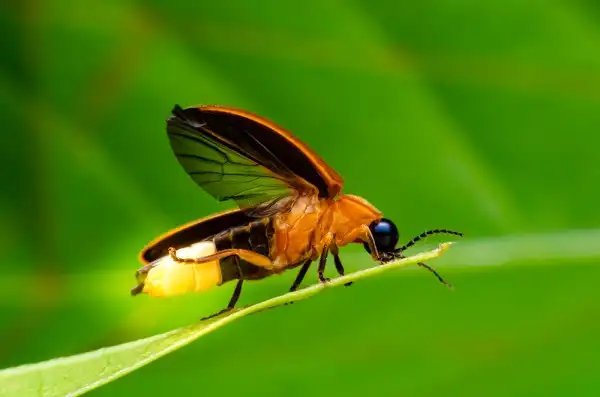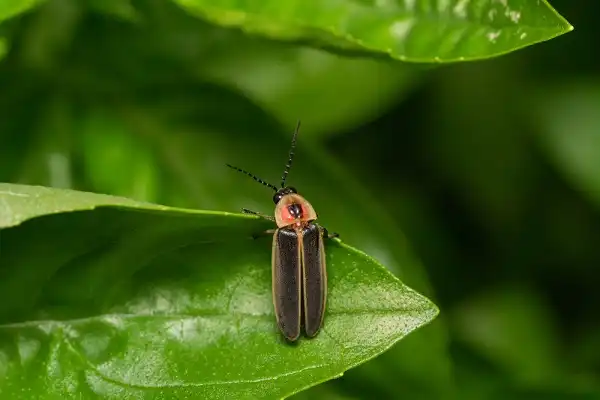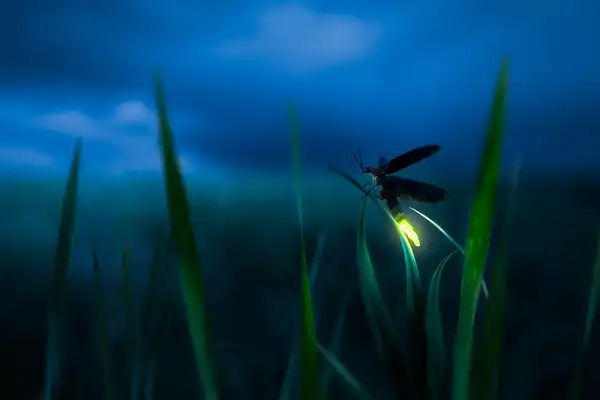Have you ever been awestruck by the beauty of a firefly in your garden on a warm summer night? The sight is simply mesmerizing and leaves an unforgettable impression. Fireflies, which are photogenic beetles commonly associated with summer evenings outdoors, add sparkle to any garden or lawn. By looking into their fascinating life cycle as well as interesting behaviors that set these beetles apart from other insects, we can get a better understanding of why they’re such captivating creatures.

Firefly Description
Fireflies are a type of beetle with a unique bioluminescence ability that sets them apart from other insects. These photogenic insects have a flattened body shape, depending on the species. Their wings are soft and flexible and are held flat over their back when at rest. The firefly’s most distinguishing feature is its ability to light up. The light is produced by a chemical reaction in the insect’s body, a process known as bioluminescence. The light is emitted from the lantern or specialized light-producing organ located at the end of the abdomen. This light is used for a variety of reasons, from attracting mates to warning potential predators of their unpalatability. Fireflies also have a fascinating reproductive strategy that involves their light-producing ability. Male fireflies fly around illuminating themselves in a specific pattern, while females wait on the ground responding with a series of short flashes. This process is known as “flash signaling” and helps the male to locate a receptive female for mating.
Firefly Habitat
Fireflies are found in a variety of habitats worldwide, including tropical and temperate regions. They prefer wet areas with tall grass, bushes, and trees, and are commonly found in meadows, forests, and fields. Firefly larvae require moist soil and leaf litter to thrive, making them common in wooded areas near marshes, ponds, and streams. Different species of fireflies have adapted to different environmental conditions. Some fireflies prefer warmer climates with higher humidity, while others do well in cooler, drier conditions. Each species also has specific habitat preferences for its larvae and adult stages, allowing them to survive and reproduce successfully. Fireflies are sensitive to environmental changes, and any disturbance to their habitat, such as deforestation or the use of pesticides, can have a significant impact on their population. With the increasing urbanization and the loss of natural habitats, firefly populations are at risk of declining. Therefore, it’s crucial to protect their habitats and preserve their natural environment to ensure their survival.
Firefly Diet
Fireflies have a primarily carnivorous diet, feeding on a variety of small insects, including springtails, snails, and other insects. Some species of fireflies, such as the larvae of the European glow-worm, are active predators, preying on other insect larvae, including snails and slugs. Firefly larvae are voracious predators, consuming large quantities of invertebrates found in their natural habitat. They have a specialized pair of mandibles to crush their prey, which they inject with digestive enzymes. The larvae of some species also use their bioluminescence to attract prey, luring other insects into their grasp with their glowing light. As adults, fireflies are primarily focused on reproduction and do not require a significant amount of food. They typically feed on nectar and pollen from flowers, with some species also feeding on other small insects in their environment. Male fireflies, in particular, require less food than females, as their primary focus is finding a mate.
Firefly Size
Fireflies come in a range of sizes, with some species measuring less than half an inch in length, while others can grow up to an inch long. In general, males tend to be smaller than females, although the size and shape of the body can vary greatly between species. One notable physical characteristic of fireflies is their flattened body shape, which helps to reduce their visibility and makes them more difficult for predators to catch. This flattened shape also allows them to squeeze into tight spaces, such as under leaves or between blades of grass. Fireflies have soft and flexible wings, which are used for flying and gliding through the air. The wings are often held out to the sides of the body when in flight, creating a distinctive silhouette that is instantly recognizable to many people.

Firefly Lifespan
Firefly lifespan varies greatly depending on the species, with some living only a few weeks while others may survive for up to two years. Most species of fireflies only live in their adult form for a short period, typically ranging from a few days to a few weeks. During this time, their primary focus is on mating, with males using their flashing bioluminescence to attract females. Once they have mated, the adult fireflies typically die soon after. However, the larval stage of fireflies can be much longer, with some species spending several years in this phase before eventually pupating and emerging as adults. During the larval stage, fireflies are active predators, hunting and consuming other insects in their environment. They also undergo several molts, shedding their skin as they grow and develop. Interestingly, the length of the larval stage can vary depending on a range of factors, including temperature, humidity, and the availability of food. In some cases, the larvae may even enter a state of diapause, pausing their development until environmental conditions become more favorable for growth.
Firefly Behavior
Firefly behavior is a fascinating subject for those intrigued by the natural world around us. These small insects are known for their distinctive bioluminescence, which is used for communication and signaling to potential mates. However, there are many other intriguing aspects of firefly behavior that deserve further exploration. Fireflies are primarily active at night, spending much of their time calling out to potential mates using their flashing lights. Different species of fireflies have different flashing patterns, colors, and rhythms, and they are often able to distinguish between individuals of their own species and those of other species. One of the most interesting aspects of firefly behavior is their use of chemical signals to communicate with potential mates. Male fireflies produce pheromones that are used to attract females, with different species using different types of pheromones to signal their interest and availability. Another fascinating aspect of firefly behavior is their tendency to synchronize their flashing displays. Some species of fireflies are known to coordinate their flashing patterns with other members of their species, creating a mesmerizing and beautiful natural light show. The reasons behind this synchronized behavior are not yet fully understood, but scientists believe that it may have to do with enhancing mating success or confusing potential predators.
Firefly Speed
Fireflies are small insects that are known for their remarkable speed. They are incredibly fast fliers, thanks to their specially adapted wings that allow them to maneuver quickly and easily through the air. One of the key factors that contribute to the speed of fireflies is their lightweight bodies. They are able to fly easily and efficiently due to their small size and low weight. In addition, their wings are flexible and designed to generate lift, allowing them to soar through the air with ease. Another factor that contributes to the speed of fireflies is their ability to thermoregulate. This means that they are able to regulate their body temperature, which in turn allows them to maintain optimal energy levels and muscle function. As a result, they are able to fly quickly and efficiently for extended periods of time, even in more challenging environments. Certain species of fireflies are known to be particularly fast fliers, capable of reaching speeds of up to 5 mph or even higher. These insects are able to move quickly through the air, zigzagging and darting around with impressive speed and agility.

Firefly Hunting
Firefly hunting is a common activity among nature enthusiasts, who are mesmerized by the dazzling displays put on by these small insects. However, it is important to note that fireflies play an important role in ecosystems and should not be disturbed excessively. Fireflies are often hunted for their beauty, with people collecting them in jars or using them for decorative purposes. However, this practice can have negative impacts on the firefly population. It is important to remember that collecting fireflies can disrupt their natural mating patterns and behavior, which can have serious consequences for the species. If you do choose to observe fireflies in the wild, it is important to do so responsibly. Use only red light sources and avoid shining bright lights, as this can disrupt their behavior. It is also important to avoid disturbing their natural habitats and mating patterns.
Firefly Anatomy and Life Cycle
Fireflies are unique insects with a variety of specialized body parts and behaviors. They have two sets of wings, which are used to maneuver in the air quickly and efficiently. Their abdomens contain light-producing organs known as lanterns, which they use to communicate with one another during mating season. Moreover, fireflies also possess special sensory organs that allow them to detect changes in air temperature and moisture levels. The life cycle of a firefly typically takes place over several months throughout the summer and fall. During springtime, adult fireflies lay eggs near their food sources, often on plants or rotting wood. The eggs hatch into larvae after a few weeks, usually around late June or early July. These larvae feed on small insects until they reach maturity and become adults. Finally, after several weeks, the adult fireflies will mate and lay eggs in preparation for the next generation of fireflies.
Firefly Role in Ecosystems
Fireflies play an important role in their ecosystems by preying on other insects such as spiders, aphids, and moths. As predators, they help to control insect populations and keep them in balance with their environment. Additionally, they use their bioluminescent lanterns to attract mates during mating season; this behavior is essential for maintaining population numbers. For these reasons, it is important that we take steps to protect firefly habitats so that future generations can continue to benefit from their beauty and ecological importance.

Conclusion
Fireflies are remarkable creatures whose speed, agility, and adaptability make them a vital part of many ecosystems. Although firefly hunting can be an enjoyable activity, it is important to remember that these insects play an important role in the environment and should not be disturbed excessively. By treating fireflies with respect and taking steps to preserve their natural habitats, we can ensure that they continue to thrive in the wild. To summarize, fireflies are impressive creatures whose speed and agility contribute to their success as key species in many ecosystems. It is important to observe fireflies responsibly by minimizing light pollution and avoiding disturbances to their natural habitats.
Frequently Asked Question


